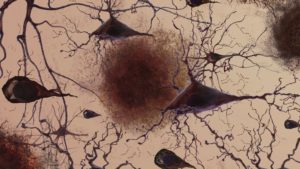
Credit: cantechletter.com
Researchers at the Salk Institute in La Jolla, California, have found that cannabinoids such as tetrahydrocannabinol (THC), the active compound in marijuana, can facilitate the removal of beta amyloid from nerve cells. Beta amyloid is one of the main components of the destructive plaque found in the brains of people with Alzheimer’s disease.
The findings of the study, which was done on nerve cells grown in the laboratory, are preliminary. However, they reinforce earlier research that demonstrated that substances known as endocannabinoids — cannabinoids produced by nerve cells — serve a protective function in the brain. These natural cannabinoids are important to intercellular signaling, or communication between nerve cells. They also appear to play a role in decreasing inflammation, which contributes to cell death.
With this study, the Salk researchers have shown that THC binds to the same receptors in the brain as endocannabinoids and has a similar neuroprotective effect. According to Professor David Shubert, the lead author of the study, this is the first time that research has demonstrated that cannabinoids “affect both inflammation and amyloid beta accumulation in nerve cells.”
Mechanism Unclear
Alzheimer’s disease currently affects over 5 million Americans and is the sixth leading cause of death in the United States. There are few treatments and no cure for the illness, which is characterized by progressive memory loss and diminished cognitive function. Scientists believe that changes in the brain, including the accumulation of beta amyloid plaque and “tangles” made up of a protein known as “tau,” are responsible for the disease. However, the exact mechanism is still unclear.

A photo of nerve cells disrupted by beta amyloid plaques
Credit: pbs.org
For the Salk study, researchers examined nerve cells that had been modified to produce large amounts of beta amyloid in order to mimic conditions found in Alzheimer’s disease. Not surprisingly, they found that high levels of beta amyloid were associated with increased inflammation and a higher rate of cell death. They then exposed the nerve cells to THC, which reduced the levels of beta amyloid and decreased the inflammatory response, thus allowing more cells to survive.
A Possible Path to New Therapies
The research is important because scientists have always assumed that the inflammation in Alzheimer’s disease was a response to “immune-like cells in the brain, not the nerve cells themselves,” said Antonio Currais, a researcher who worked with Dr. Shubert on the study. But, he adds, “when we were able to identify the molecular basis of the inflammatory response to amyloid beta, it became clear that THC-like compounds that the nerve cells make themselves may be involved in protecting the cells from dying.”
While this research is promising, Dr. Shubert emphasized that it does not yet support the use of cannabinoids as a treatment for Alzheimer’s disease. That possibility will need to be explored further in clinical trials.
Did you enjoy this article? If so, you may want to read about a study that suggests medical marijuana could save millions of dollars in Medicare costs.

 Cannabinoids May Remove Plaque in Patients with Alzheimer’s Disease
Cannabinoids May Remove Plaque in Patients with Alzheimer’s Disease


 The Other Death in the Family
The Other Death in the Family

 The Healing Sound of Singing Bowls
The Healing Sound of Singing Bowls














